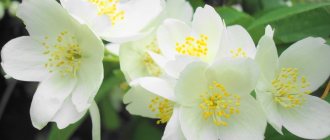Probably, many people associate the rosehip plant with the village, where in the summer this miracle bush is covered with beautiful flowers, and in the fall grandmothers harvest the fruits, saying that they are very good for health. All grandmother’s stories are true, they can only be supplemented by the fact that in addition to the great benefits for the human body, the plant has an impressive number of species, the visual beauty of which can outshine other prominent representatives of garden crops. When thinking about which group of plants rosehip belongs to - medicinal or ornamental, it is impossible to give a definite answer. We can say with confidence that this culture deserves special attention.
Description of the plant Rosehip
Rosehip (Rōsa) is a shrub (subshrub) belonging to the Rosaceae family. It has about 500 species, and an even greater variety of varieties, according to some sources reaching fifty thousand. The traditional rose in our understanding is one of the cultivated species of this shrub. The plant dates back to ancient times and has a large number of different names that are used by gardeners. For example, it is often called “wild rose”, “shupshina”, “thorn color”. Why the rose hip plant was called this is explained quite simply - the bush has protective thorns located along the entire length of the branches. According to some historical versions, the name of the plant comes from the word “thorn” (thorn or point).
Most species are deciduous shrubs, but evergreens are also found. The most common species in gardening are represented by shrubs reaching three meters in height and having a well-branched crown. Less common are dwarf varieties, the maximum height of which reaches 25 cm. The plant is a long-livers, living up to fifty years or more.
"Wild Rose" has a taproot system, the main root of which can go deep into the ground up to five meters. The branches are erect, arched, abundantly covered with thorns. On young branches the thorns are soft, on adult branches they are hard and very sharp. The bark of the shoots is dark brown, dark red. The foliage on the branches is arranged spirally and has a reddish, bluish or greenish color. The leaf blades are hard, leathery and have a round or elliptical shape. The edge of the leaf is uneven, covered with a large number of serrations (serrate, double-serrate).
The perennial rosehip plant blooms with bright flowers, the diameter of which can reach 10 cm. The flowers can be single or collected in shield-shaped, paniculate inflorescences. The petals come in different shades: snow-white, yellow, cream, red or pink. During flowering, the garden is filled with a delicate, pleasant aroma. The flowering period begins in late spring, early summer and lasts about three weeks.
At the age of three, the bush begins to bear fruit. Rose hips are visually similar to small (1-1.5 cm long), round nuts of red, orange, sometimes purple or black. It contains a large number of seeds inside. The pulp is fibrous and has a tart-sweet taste. The fruit ripens in early autumn.
Questions about rose hips
Tree or shrub
Wikipedia says that Rosehip is a deciduous shrub with straight or creeping branches. Depending on natural conditions or care for the bush, it grows to different heights, but not more than 3 m .
Dog-rose fruit
Other sources also say that it is a shrub of varying heights and does not have a central trunk so that it can be classified as a tree.
Useful features
Rose hips contain many vitamins and other beneficial substances. And therefore the plant has many features :
- The fruits are used to make teas, pastes, jams, compotes, sweets and much more.
- Jam is made from Rosehip petals
- In Slovenia, the fruits are added to wines and give them a special taste.
- In the Caucasus, young shoots were eaten, and young leaf blades were brewed into tea .
- Pharmacological factories make various vitamins, syrups, and extracts .
Rosehip plant: planting and care
The shrub is unpretentious in care. It is preferable to plant in the garden in mid-autumn in well-lit areas of the garden. Considering that the root system is quite developed and very deep, it is not recommended to place it in lowlands where moisture can accumulate, in areas with nearby groundwater. Excessive moisture leads to rotting of the rhizome. The soil is preferably fertile, neutral acidity. The soil should be loose and well drained.
Young seedlings need regular watering, but you should avoid waterlogging the soil. Mature bushes can do without watering, being content with natural precipitation. In the hot, dry season, water should be watered as the soil dries out.
For intensive growth and good fruiting, the plant needs regular feeding. They begin to fertilize the next year after planting, adding nitrogen fertilizers to the soil in spring, autumn and summer. In early spring and late autumn (in preparation for winter), fertilizing with organic fertilizers (humus) is also carried out.
Proper care involves regular pruning. It is carried out both for crown formation and for sanitary and health purposes. In early spring, before the buds swell, damaged shoots are pruned, thinned out and a crown is formed. Young branches are pruned, those that have reached the age of seven are completely cut out, giving the shrub the opportunity to renew itself.
Distribution of the plant in nature
About 400 varieties of rose hips are known throughout the world, mostly growing only in a certain area, and there are tens of thousands of cultivated varieties.
More than half of the species grow in Russia and neighboring countries.
The Himalayas are considered the birthplace of rose hips. Dense thickets of shrubs can often be found in the most favorable conditions for it in the Mediterranean. The culture has become more widespread in the forest part, as well as along river ravines and wet meadows, steppes and plains of the temperate zone and subtropics of the Northern Hemisphere, as well as in some mountainous areas - throughout Russia, the Caucasus, Europe and Central Asia.
The plant is not picky about soil and grows well in loamy, sunlit places of moderate humidity, so different types of rose hips are found on all continents except the Arctic - from the Arctic Circle to the American continents, Australia and New Zealand.
Culture propagation
Rosehip is an angiosperm plant that can be propagated by seed or vegetative methods. Let's take a closer look at each of them.
Growing Rosehip from seeds at home
For propagation, seeds are collected in August from unripe fruits. You can sow seeds in open ground in October. To do this, add a small amount of humus mixed with sawdust into the prepared grooves. Sow the seeds at a distance of 5 cm from each other. The first shoots appear next spring. To speed up germination, in the spring the planting can be covered with plastic film, thus creating a protective cap. When using film, it must be removed regularly for ventilation and watering. After the emergence of seedlings, the film is removed, and when the seedlings have several strong leaves, they are planted.
You can sow seeds in spring. In this case, they need preliminary stratification. The seeds are first mixed with sand and peat and placed in the refrigerator for a while.
The seed method of propagation does not fully guarantee the preservation of all characteristics of the mother culture. To fully preserve them, it is advisable to use propagation by cuttings and offshoots.
Growing Rosehip from cuttings
Cuttings are often harvested in spring, summer, and less often in autumn. For cuttings, young, non-lignified shoots with buds are selected. Cuttings from young, healthy shoots take root quickly. The cuttings should have 2-4 viable buds. A sharp, horizontal cut is made above the upper bud, and an oblique cut is made from below the shoot.
Half of the foliage from the shoot must be removed, leaving only those at the top. The bottom of the cutting is treated with a special agent for intensive root growth and buried in the prepared soil. It is advisable to protect the planting with a cap, creating greenhouse conditions. Regularly airing and watering the seedling will quickly take root.
Reproduction of shrubs by offsets
Side branches may appear from the root of a perennial shrub, which are suitable for creating a branch. If the shoot is large enough (height from 25 cm), it can be carefully cut out with a sharp shovel and transplanted to a separate place. It is better not to immediately separate small branches from an adult bush. They are first bent a little to the side and sprinkled with soil. Periodically, the soil is added and compacted. When the offspring separates from the adult plant, it can be dug up and replanted separately. It is better to do tappings in the spring; the young seedling will have the opportunity to prepare for winter.
Peculiarities
The venation of the rosehip leaf is clearly pronounced. Each of them has one central vein and from 4 to 13 lateral veins. Branching can be weak or strong. The lateral veins, as a rule, do not reach the edges of the leaf; they can connect with each other and, branching, approach the teeth or end without loops. Veins rarely protrude from the underside of the leaves, but there they are more pronounced.
Most rosehip stipules are narrow. They can be incised, pinnately dissected or jagged. Also in some cases they expand towards the base. In this case, they turn into elongated wide so-called “ears”. In this case, the stipules, as a rule, grow together with the cuttings.
Types and varieties of Rosehip
Among the species and varietal diversity, when selecting for a garden plot, it is worth paying attention to such crops.
Rose hip plant (Rosa majalis)
the most popular species, widespread in Europe. Its height reaches three meters, the branches form large thorny thickets that require regular thinning.
The flowers are large, the petals are pale and bright pink, there are varieties with double flowers. The branches are abundantly covered with thorns. Frost-resistant species.
Dahurian rose hip (Rosa davurica)
Grows up to 1.5 height. The leaves are imparipinnate, up to 8 cm long, with slight pubescence below. The bark is brown, purple-black.
It blooms in early summer with small dark pink flowers. It is distinguished by a small number of thorns, located in pairs at the base of branches and leaves. The fruits are red;
Rosehip (Rosa rugosa)
Oriental, very decorative representative of the genus. They mistakenly think that wrinkled rosehip is a herbaceous plant.
Its height reaches 2.5 meters, and its branches are spreading. It got its name because of the leaves, which are visually strongly wrinkled and have gray-green pubescence. Large flowers (up to 12 cm in diameter) with pink and white petals, collected in fragrant inflorescences. The bush blooms all summer, because of this, on its crown you can simultaneously observe loose and withered buds and ripe berries.
"Ray"
The bush is tall (up to 3 m tall), erect. There are a small number of thorns on the green branches. Basically, the thorns are located at the base of the bush. Blooms pale pink. Red oval berries are large, weighing up to 5 g. Properties: frost resistance, resistance to diseases, pest damage. The ripening process begins in August.
Medicinal properties of the rose hip plant
The medicinal plant rose hips is a storehouse of useful substances. It is used in folk medicine, pharmacology, and cosmetology as an additive to various medicines and cosmetics.
All components of the crop are used in medicine: fruits, petals, branches, leaves and roots. The fruits of the bush are rich in antioxidants and vitamins. Used for the production of vitamin complexes used for exhaustion and anemia. Also, the components of the culture are used in medicines intended to treat diseases of the gastrointestinal tract and genitourinary system. Infusions and extracts are used in cosmetology in the treatment of acne and other skin diseases.
You can talk a lot about the benefits of this bush, but you should also warn about caution. Decoctions and infusions with its components should be limited to people with high blood pressure. Long-term use of medications based on this shrub is not recommended for people with liver problems; its components can inhibit the process of bile excretion. People with heart problems should also be careful. Like any medicinal plant, rosehip can be useful, but if used incorrectly it can cause harm, exacerbating chronic ailments. When taking medications, you should definitely consult a specialist.
Rosehip flowers (petals)
Rose oil is obtained from rose flowers and is actively used in aromatherapy. It is also used to improve the taste and smell of medicines. In Bulgaria, based on this oil, the drug “Rozanol” is produced, which is used for diseases of the biliary tract, liver, and urolithiasis. Dry crushed rose petals are present in herbal soothing pillow fillings.
Rose petals are present in herbal preparations, which in folk medicine are used to strengthen the immune system, for influenza, neurasthenia, conjunctivitis (in the form of drops), hemorrhoids, allergic manifestations, ulcers and long-term non-healing wounds. Rosehip petals can be used internally for diseases of the gastrointestinal tract, diarrhea, hypertension and atherosclerosis.
Rose hips truly have healing powers. Therefore, do not neglect this plant when you have it in your garden, take a closer look at it, and think about collecting and preparing it. Currently, it is widely used in modern and folk medicine, the cosmetic industry, and also in cooking.
Rosehip jam . Rinse the ripe rose hips, remove the seeds and remove the hairs. Then for 1 kg of peeled fruit you need to take ½ cup of water and boil until softened. Rub the softened fruits through a sieve (stainless steel) and cook for about an hour. First you need to boil without adding sugar, but 15 minutes after boiling, about 800 g of sugar is needed per 1 kg of the resulting puree. Finish cooking. Distribute the finished jam into glass liter or 1.5 liter jars and pasteurize in boiling water for 20–25 minutes.
Author: Ekaterina Solovyova
Please note that the information presented on the site is for informational and educational purposes only and is not intended for self-diagnosis and self-medication. The selection and prescription of medications, treatment methods, as well as monitoring their use can only be carried out by the attending physician. Be sure to consult a specialist.











